Curtis Mann is a defacer and destroyer of photographs: through manipulation by file, nail, chemical and abrasive, Mann alters and shifts pictures of both the banal and politically-loaded into new works. In what they lose by being defaced, they gain by being made more alien, inscrutable and strange — reality abstracted with heavy gravity added, in a sense.
While Mann, a third-year graduate student in the photography program at Columbia College of Chicago, can be pigeonholed as a photographer by virtue of his academic associations and his work with photographs, it may be of better service to call Mann an alchemist or tinkerer. Pictures of his sister and parents are chemically treated so that their bodies and faces are burned, erased; photos from Israel and Iraq are manipulated so that scenes of desert landscape, people and bombed-out buildings become alien. Depictions of both the banal and foreign made strange or stranger by the application of caustics.
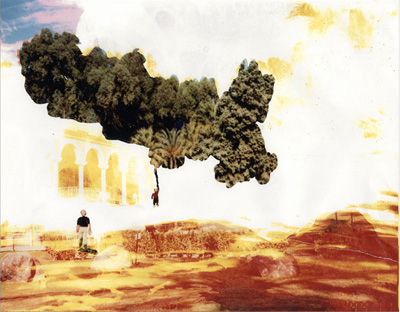
Lately Mann is finding himself to be the center of an increasing amount of attention. The inclusion of his work in last autumn's Silverstein Photography Annual at the Silverstein Gallery in New York City, and in the "Strange Habits" show at the I Space gallery in Chicago coming up in the spring, have given Mann, a native of Dayton, Ohio, a major boost to his reputation.
The path that Mann has taken on his way to becoming a photographer is one marked by detours and convolutions. A long time ago, Mann was once a mechanical engineer and more familiar with the fatigue point, yield strength and elastic limit of metal alloys than with the nuances of modern conceptual photography. How he got into photography is a story familiar to many: a series of photography classes taken in his fifth and final year of engineering school at the University of Dayton opened Mann's eyes to the photographic process. The camera and process of image development was immediately familiar, the procedure comfortable.
With time spent working out some long-tamped ideas from behind the camera, the idea of being an engineer for the rest of his professional life no longer had the appeal it once had. Between terms at school and in Hawaii on a short sabbatical from the Continental U.S., Mann registered for a regimen of photography classes via payphone, and stepped across the divide from engineer to artist.
That's not to say that the precision and attention to detail that engineering demands has left Mann. Rather, it has become an integral part of his artistic repertoire. However, the process by which he added bleach and nail to his toolbox is a natural one, albeit aided by a professor, Joel Whitaker, who showed Mann that one could take found photographs, physically alter them, and present them as new images. "I had never thought you could make pictures with pictures, the idea of appropriating imagery instantly grabbed me. Joel walked by me one day as I had wet prints in an array and said, 'why don't you tear that?' I tore a couple, put them back together and re-photographed them."
That initial experiment led to further experimentations using fire, knives and glue. Varnish painted on a print could preserve the details and color that bleach washed away. After so many trials, including the completion of a series of photos that practiced the techniques of eradication on images of his family and others, Mann shifted his focus from the familiar to the foreign.
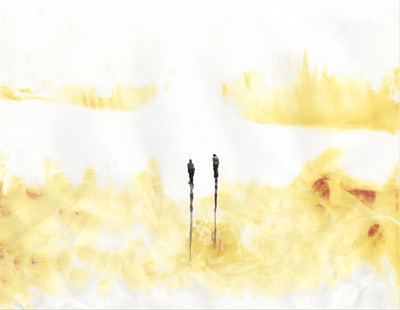
"Modifications," the title of Mann's series featured in the Silverstein exhibition, is just that: photos of Israelis engaged in the mundane, desiccated landscapes, buildings both intact and destroyed, all distorted and treated so that whatever it was that the subjects of those photographs were is no longer readily apparent. "Escape Attempt" depicts what looks to be a child suspended from a parasol of greenery, floating away from the pale yellow ground. "The Group Descending" shows a line of children in procession with strange clouds tethered to their heads by thin white ropes — ropes reminiscent of The Fates' threads of life. These threads also appear in "The Collective," which shows a gathering of people, a dark, billowing cloud hovering over their heads. To Mann, this photo represents the process of groupthink, albeit permeated by a sort of sinister spookiness. "For me, well I wanted them to become a team; try to think together; but in the end I wanted to leave a tension that they could be failing together, too."
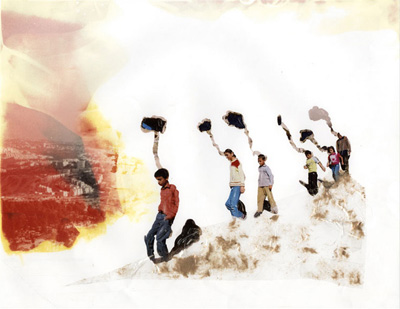
Other pictures from the same series show bombed-out buildings and rubble floating away, the light and background white and hot. With the knowledge that these reworked images are of scenes of war and the destruction that comes from bomb blasts comes a sense of serious weight and import — these aren't pictures of a plain old torn down building, construction site or group of people on the corner.
These are artistic manipulations of snapshots, selectively destroyed to emphasis certain elements and remove others. And while it just so happens that these works are of Israel or any other state torn apart by political and religious strife — such as Afghanistan, Kenya, Darfur — there is still a heady element of playfulness running through these pictures.
Mann explains this dichotomy: "I really try to give those more charged images an element of whimsy, and the playful images, I try to make more charged and serious." But why these images of Israel, Pakistan, Kenya, Iraq? All these places are home to turmoil and unrest, but yet, all places where people still try to eke out a normal existence.
According to Mann, this project was less the result of some intentional process, and rather, the culmination of a series of happenstance. "At one point, I ended up with an entire set of pictures from Israel and at the same time I was reading a text about Israel and Palestine that my sister was also reading. And I just decided to take this leap, I could learn about this," adding "These are all places that I want to understand, places that I want to have a dialogue with, and pull meaning from."
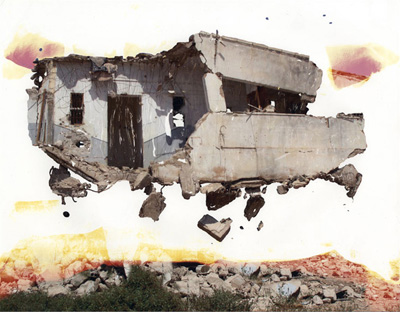
One wonders why Mann has chosen to learn about the struggles of these places by manipulating images of its people, land and buildings. It's something that Mann himself struggles with — the situation in the Mideast is so complicated and convoluted that it's easy to fall off the thin line into polemical argument or artistic sloganeering with only one small misstep. "I decided to never take a side. It's too difficult and complicated of a problem to take a side, it doesn't solve anything," he said. "My goal was then to create imagery that removed the context of the specific place."
It is this removal and alteration of context that also makes Mann's work so compelling, as it is by random chance that some of his images are what they are. "The chemical process is one stage (in my work) in which my control is not absolute, it sort of acts the way it wants to act. This idea of control is also important to me. I use other people's pictures, which further removes my control of the image. I have always liked work where there is at least a partial sense of discovery or loss of control, but the artist is still able to make what they (originally) desired."
Furthermore, by the process inherent to his work and by working with photos of war-torn regions, Mann has battled both with himself and others over the nature of his work. "I struggled with the process for a while because it looks very aggressive and apocalyptic at first glance. People tried to read more into my psychology, what might be wrong with me. Why was I doing this to these photographs?"
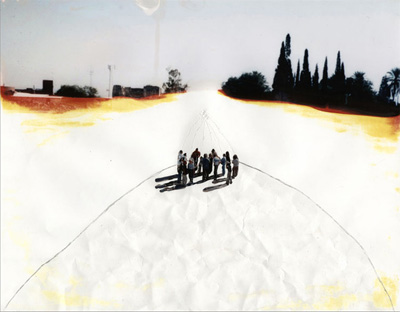
One reason, Mann admits, is that at one point he intentionally charged his images with real gritted grimness as a sort of test, something that he's now trying to shake off. "When I first started, my pictures were ambiguous in nature, and they progressively became more and more politically and socially charged. Now I'm trying to bring back that ambiguous quality — to start letting my pictures speak for themselves."
Regardless of the controversial content of his work, the experience of showing his altered photographs at the Silverstein Gallery has allowed Mann to receive input from sources far removed from the oft-cloistered environment of graduate school. "Showing at the Silverstein really pushed me and my work this past year," Mann said. "People were interested, people were pointing, looking from below and the side trying to get at the textures. I had a long conversation with a couple of collectors and they were actually reading into the narratives in the work and it was in the same ballpark as what I was thinking, which also gave me hope."
And with four upcoming shows — including one at GASP Gallery in Boston in the spring, curated by Columbia College professor Dawoud Bey, titled "Concerning Tomorrow"; another in New York as part of the New York Photo Festival in May, curated by Lesley A. Martin; and closer to home, his thesis exhibition at Columbia College — the hope that Mann feels about the potential of his work is certainly warranted.
You can see more of Curtis Mann's work on his website, CurtisMann.com. ✶





